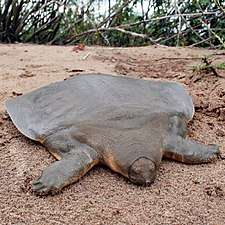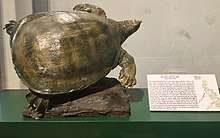Asian giant softshell turtle
The Asian giant softshell turtle (Pelochelys cantorii),[1][2] also known as Cantor's giant softshell turtle[2] and the frog-faced softshell turtle, is a species of freshwater turtle in the family Trionychidae. The species is native to Southeast Asia. It has been considered to be among the largest extant freshwater turtles. The species is endangered and in the 20th century has disappeared from much of its former range.
| Asian giant softshell turtle | |
|---|---|
 | |
| Scientific classification | |
| Kingdom: | Animalia |
| Phylum: | Chordata |
| Class: | Reptilia |
| Order: | Testudines |
| Suborder: | Cryptodira |
| Family: | Trionychidae |
| Genus: | Pelochelys |
| Species: | P. cantorii |
| Binomial name | |
| Pelochelys cantorii | |
| Synonyms[3] | |
| |
Taxonomy
The species is not found in New Guinea, while the two other members of the genus Pelochelys, P. bibroni and P. signifera are both restricted to New Guinea.[2] P. cantorii is relatively unstudied, and the current species may actually be composed of several taxa.[4] One study from 1995[5] showed what was once thought to be P. cantorii in New Guinea was actually P. bibroni, and the earlier studies[6][7] of P. cantorii only described populations further to the west.
Description
The Asian giant softshell turtle has a broad head and small eyes close to the tip of its snout. The carapace is smooth and olive-colored. Juveniles may have dark-spotted carapaces and heads, with yellow around the carapace.[4]
Despite reports that it can grow up to 1.8 metres (5.9 ft) in length and is the world's largest extant freshwater turtle, this maximum size and title is murky at best.[8][9] Apparently the largest specimen carapace length, 129 cm (51 in), known is considered suspect and the heaviest specimen known (weighing approximately 250 kg (550 lb) was actually a misidentified Yangtze giant softshell turtle.[10][11] A more realistic range of carapace length for this species is reportedly 70 to 100 cm (28 to 39 in) and it is one of about a half-dozen giant softshell turtles from three genera that reach exceptionally large sizes, i.e. in excess of 100 kg (220 lb) in mass.[12]
The species is an ambush predator and primarily carnivorous, feeding on crustaceans, mollusks and fish (although some aquatic plants may also be eaten).[4] The turtle spends 95% of its life buried and motionless, with only its eyes and mouth protruding from the sand. It surfaces only twice a day to take a breath, and lays 20–28 eggs sized around 3.0 to 3.6 centimetres (1.2 to 1.4 in) in diameter in February or March on riverbanks.[4][9][13]
Morphological differences in neural bone count have been noted between specimens found in the Philippines and mainland Asia.[14]
The species is named after Danish zoologist Theodore Edward Cantor.[15]
Distribution and habitat
The species P. cantorii is primarily found in inland, slow-moving, freshwater rivers and streams. Some evidence indicates that its range extends to coastal areas, as well.[4] It occurs in eastern and southern India, Bangladesh, Burma, Thailand, Malaysia, Laos, Cambodia, Vietnam, eastern and southern China, the Philippines (Luzon and Mindanao), and Indonesia (Kalimantan, Java, and Sumatra).[2]
Conservation
The Asian giant softshell turtle is classified as Endangered by the IUCN and has disappeared from much of its range.[16] Prior to 2007, it was last seen in Cambodia in 2003. A 2007 survey of one area of the Mekong River in Cambodia found the turtle in abundance along a 48 kilometres (30 mi) stretch of the river.[9][17]
In the Philippines, a juvenile Cantor's turtle known as “cagot" appeared and was captured by a fisherman along the Addalam River, Cabarroguis, Quirino, Isabela. In 2001, this turtle was sent to Chicago and its identity confirmed.[18] The reptile has been evaluated as an EDGE species by the Zoological Society of London.[19]

References
- Asian Turtle Trade Working Group (2016). "Pelochelys cantorii ". IUCN Red List of Threatened Species. 2016: e.T16502A97400946.
- Rhodin, Anders G.J.; Inverson, John B.; Roger, Bour; Fritz, Uwe; Georges, Arthur; Shaffer, H. Bradley; van Dijk, Peter Paul (August 3, 2017). "Turtles of the world, 2017 update: Annotated checklist and atlas of taxonomy, synonymy, distribution, and conservation status(8th Ed.)" (PDF). Chelonian Research Monographs. 7. ISBN 978-1-5323-5026-9. Retrieved October 4, 2019.
- Fritz, Uwe; Havaš, Peter (2007). "Checklist of Chelonians of the World" (PDF). Vertebrate Zoology. 57 (2). Archived from the original (PDF) on 2010-12-17.
- Ernst, C. H.; Altenburg, R. G. M.; Barbour, R. W. (1998). Turtles of the world [CD-ROM].
- Webb, R. G. (1995). "Redescription and neotype designation of Pelochelys bibroni from southern New Guinea (Testudines: Trionychidae)". Chelonian Conservation and Biology. 1 (4): 301–310.
- Gray, J. E. (1864). "Revision of the species of Trionychidae found in Asia and Africa, with the descriptions of some new species". Proceedings of the Zoological Society of London. 1864: 76–98.
- Boulenger, G. A. (1891). "XXXI.—On the occurrence of Pelochelys in China". Journal of Natural History. 7 (39): 283–284. doi:10.1080/00222939109460609.
- "Rare Soft Shell Turtle, Nesting Ground Found in Cambodia". ScienceDaily. 19 May 2007.
- Mydans, Seth (18 May 2007). "How to Survive in Cambodia: For a Turtle, Beneath Sand". New York Times.
- De Rooij, N. (1915). The Reptiles of the Indo-Australian Archipelago. A. Asher.
- Pritchard, P.C. (2005). "Survival status and prospects for Rafetus swinhoei (Chelonia: Trionychidae)". 2005 Turtle Survival Alliance Annual Conference Proceedings: 19–22.
- Das, I. (2010). "Pelochelys cantorii Gray 1864- Asian Giant Softshell Turtle". In Iverson, J. B.; Mittermeier, R. A. (eds.). Conservation Biology of Freshwater Turtles and Tortoises: A Compilation Project of the IUCN/SSC Tortoise and Freshwater Turtle Specialist Group. Chelonian Research Monographs. 5.
- Das, I. (1985). Indian Turtles, a Field Guide. Calcutta: World Wildlife Fund--India (Eastern Region).
- Brown, RM; Siler, CD; Oliveros, CH; Welton, LJ; Rock, A; Swab, J; Weerd, MV; van Beijnen, J; Jose, E; Rodriguez, D; Jose, E; Diesmos, AC (2013). "The amphibians and reptiles of Luzon Island, Philippines, VIII: the herpetofauna of Cagayan and Isabela Provinces, northern Sierra Madre Mountain Range". ZooKeys (266): 1–120. doi:10.3897/zookeys.266.3982. PMC 3591760. PMID 23653519.
- Beolens, Bo; Watkins, Michael; Grayson, Michael (2011). The Eponym Dictionary of Reptiles. Baltimore: Johns Hopkins University Press. p. 47. ISBN 978-1-4214-0135-5.
- https://www.iucnredlist.org/species/16502/97400946
- Munthit, K. (16 May 2007). "Rare Turtle's New Chance". Associated Press.
- Taguinod, Floro C. "After seven years, rare soft-shelled turtle resurfaces in Quirino Province". GMA News Online.
- http://www.edgeofexistence.org/species/cantors-giant-softshell/
Further reading
- Das, Indraneil (2002). A Photographic Guide to Snakes and other Reptiles of India. Sanibel Island, Florida: Ralph Curtis Books. 144 pp. ISBN 0-88359-056-5. (Pelochelys cantorii, p. 139).
- Das, Indraneil; Lakim, Maklarin (December 2006). "On the Distribution of Pelochelys cantorii on Borneo" (PDF). Chelonian Conservation and Biology. 5 (2): 323–325. doi:10.2744/1071-8443(2006)5[323:OTDOPC]2.0.CO;2.
- McCord, William P.; Joseph-Ouni, Mehdi (2003). "Flapshell and Giant Asian Softshell Turtles". Reptilia. 26: 59–64.
- Webb, Robert G (2002). "Observations on the Giant Softshell Turtle, Pelochelys cantorii, with description of a new species". Hamadryad. 27 (1): 99–107.
External links
| Wikispecies has information related to Pelochelys cantorii |
![]()

